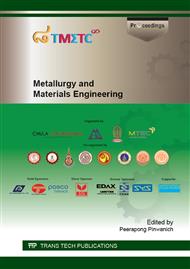p.36
p.42
p.53
p.59
p.64
p.69
p.76
p.81
p.86
Effects of Beryllium and Tin on Spring Property of Aged Silver Alloys 935 without Solutionization Treatment
Abstract:
Microstructural development and mechanical properties of as cast and heat treated 935 Ag-Cu and Ag-Cu-Be-Sn alloys without using solutionization were investigated. The conventional lost-wax process with vacuum assisted and induction heating has been performed for producing the as cast specimens. After pouring the melt into plaster mould, the casting has been prolonged for 15 minutes prior to quenching into water. Subsequently all specimens including the reference specimens, commercial specimens and Ag-Cu-Be-Sn additions specimens were aged at 250 and 350°C for a given period between 0 to 120 min according to normal aging procedure of the 935 AgCu alloy. In case of Be and Sn additions, the A1 alloy with aging at 350°C performed the combination of good mechanical properties and the surface finish with superior anti-tarnish and fire scale resistance and thus these are suitable for jewelry applications. Microstructures were characterized by using both scanning and transmission microscopes. The results show that the precipitates in the 935 AgCuBeSn alloy were detected and thus resulted in a better improvement in yield strength and modulus of resilience than those of the 935 AgCu alloy
Info:
Periodical:
Pages:
64-68
Citation:
Online since:
July 2015
Price:
Сopyright:
© 2015 Trans Tech Publications Ltd. All Rights Reserved
Share:
Citation:


